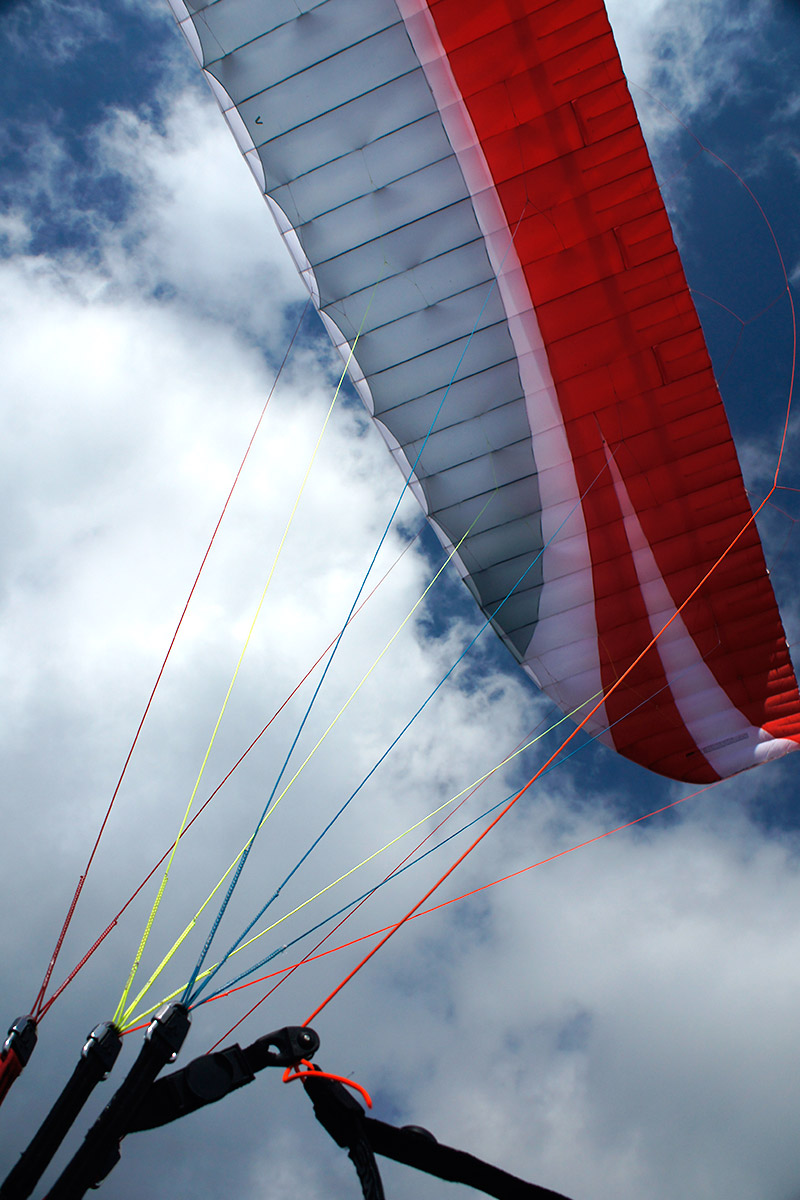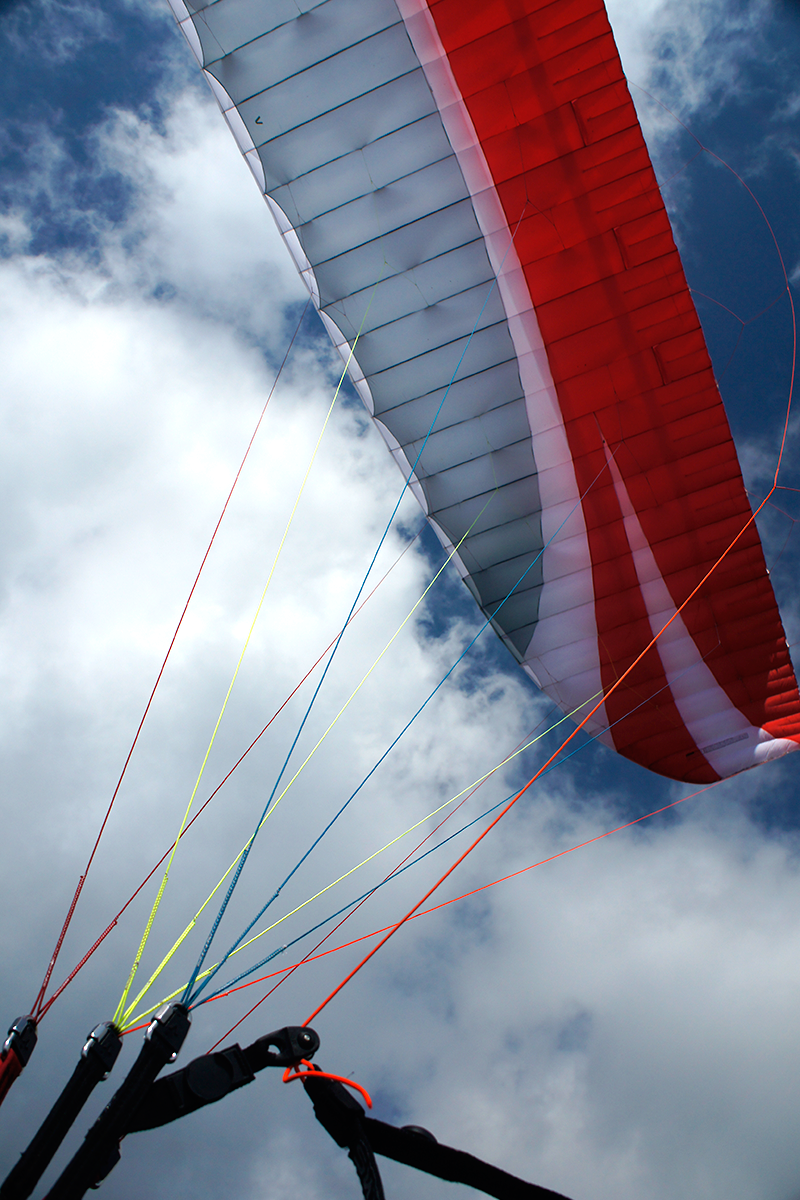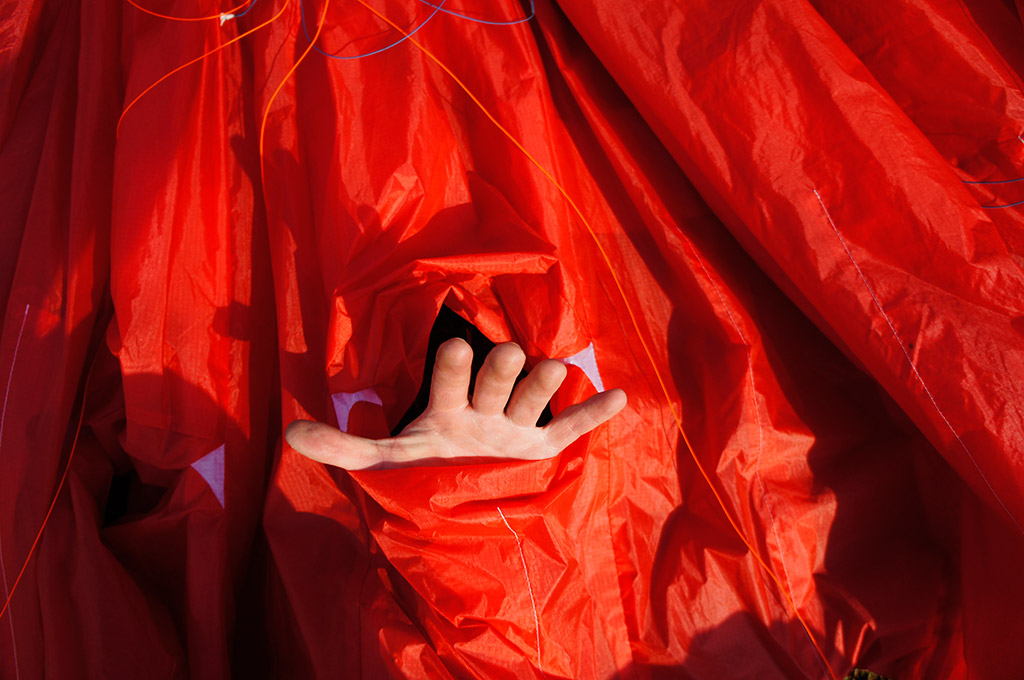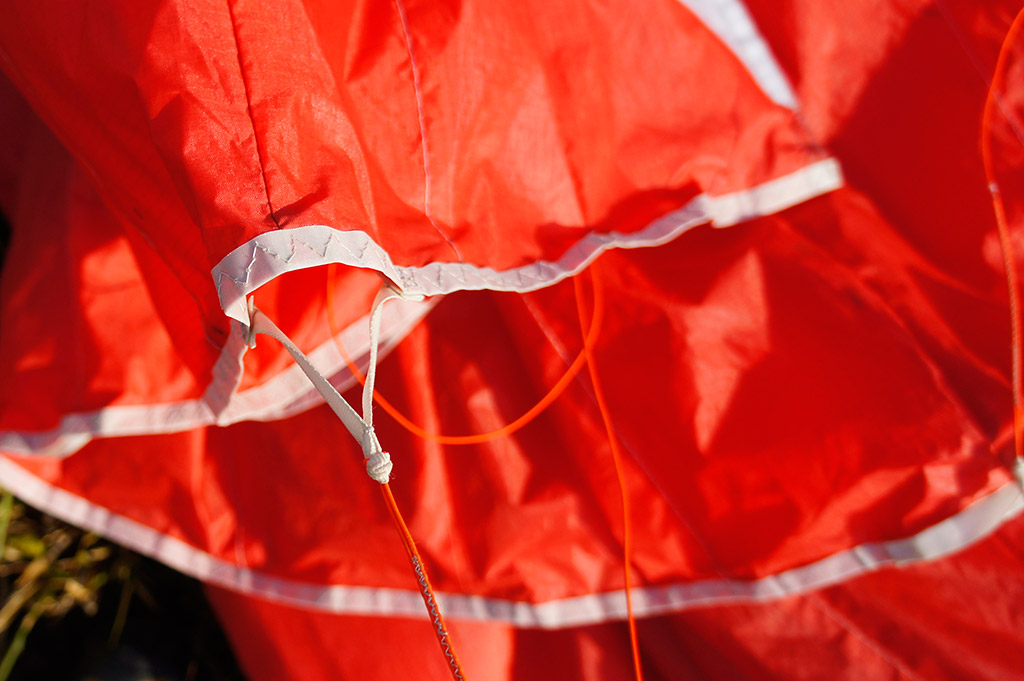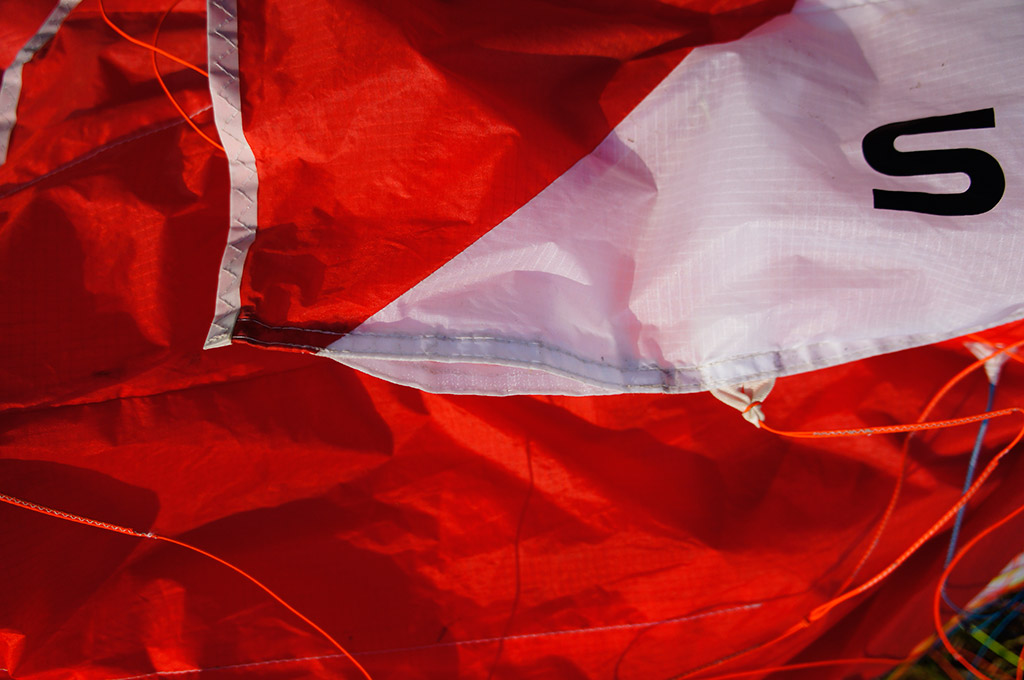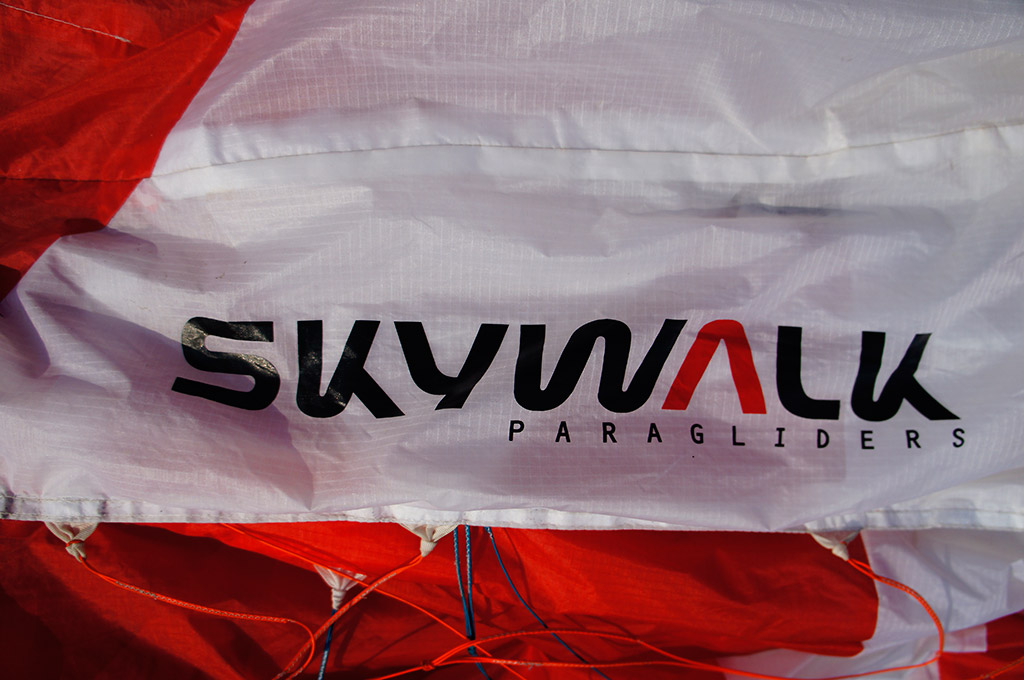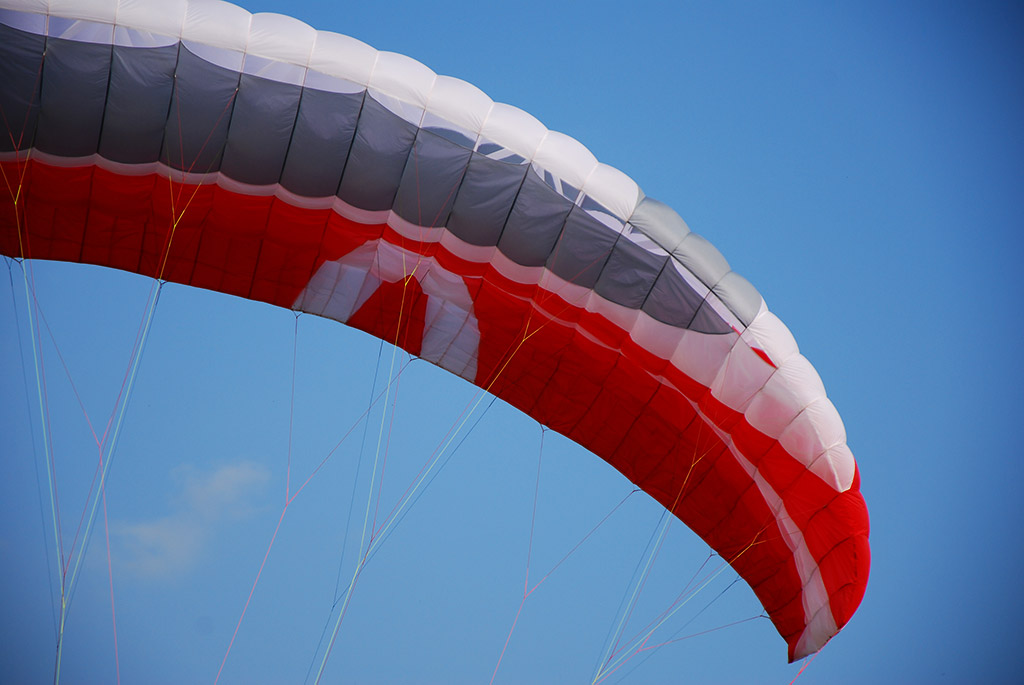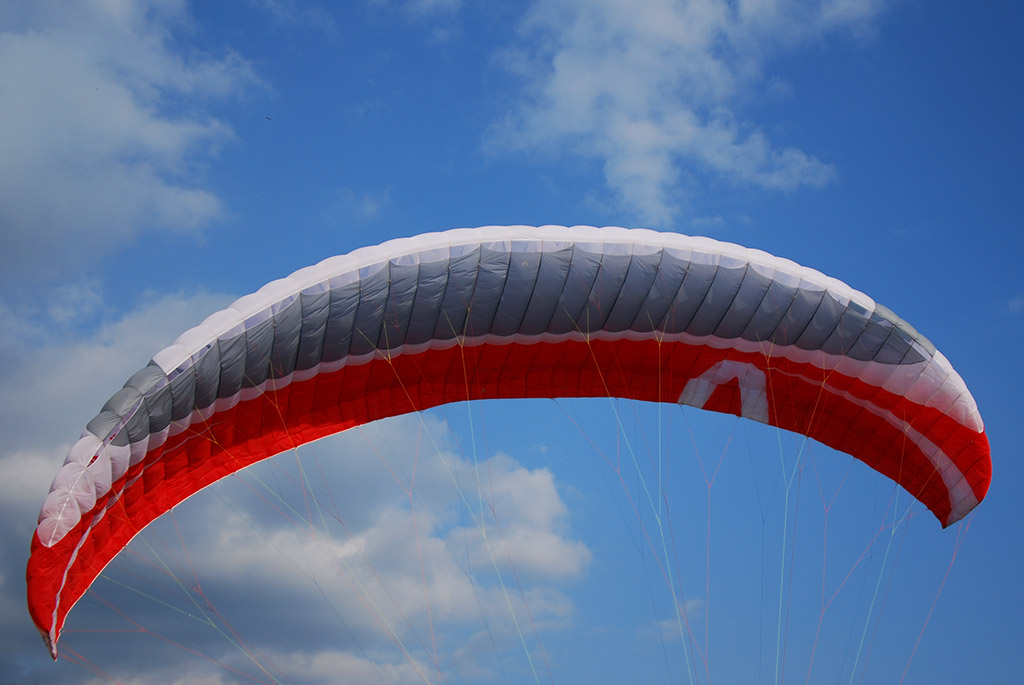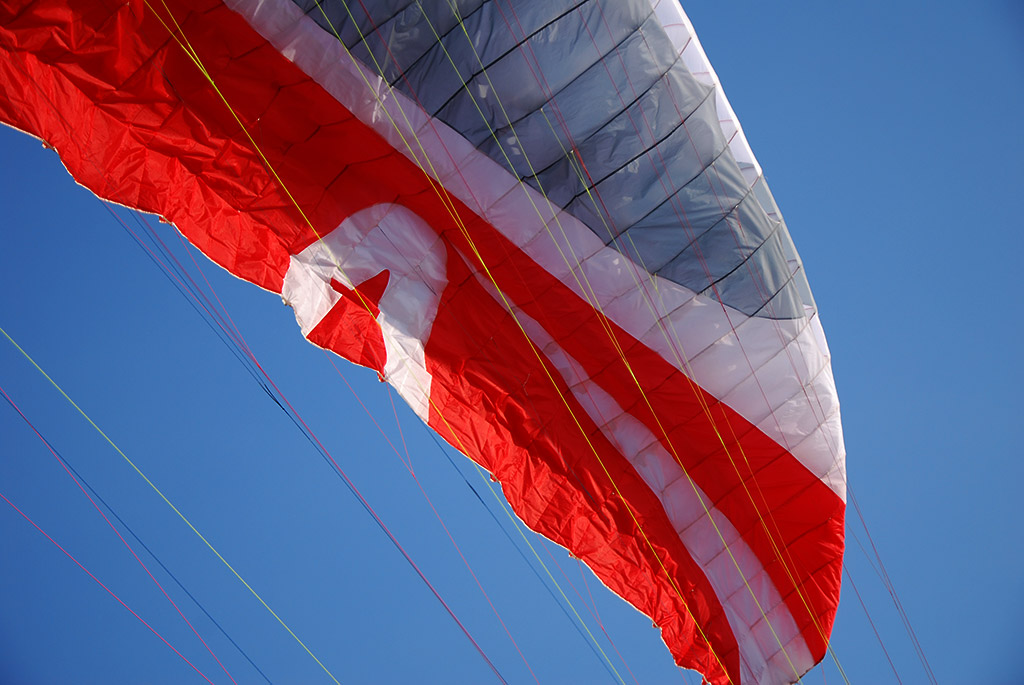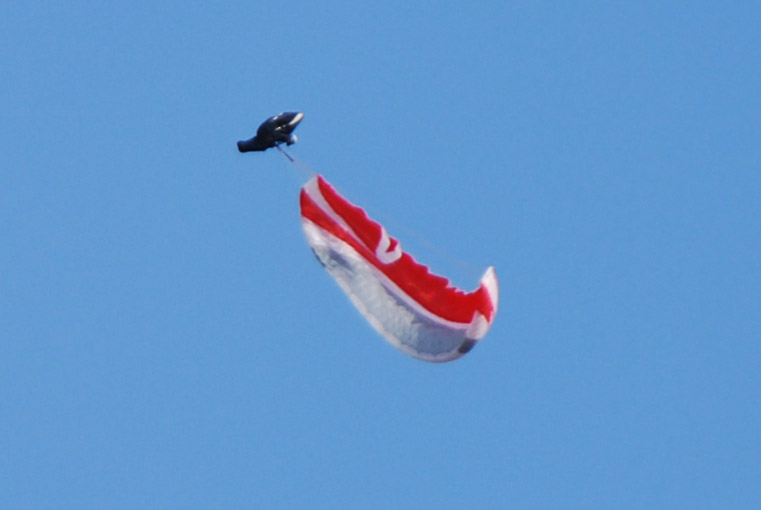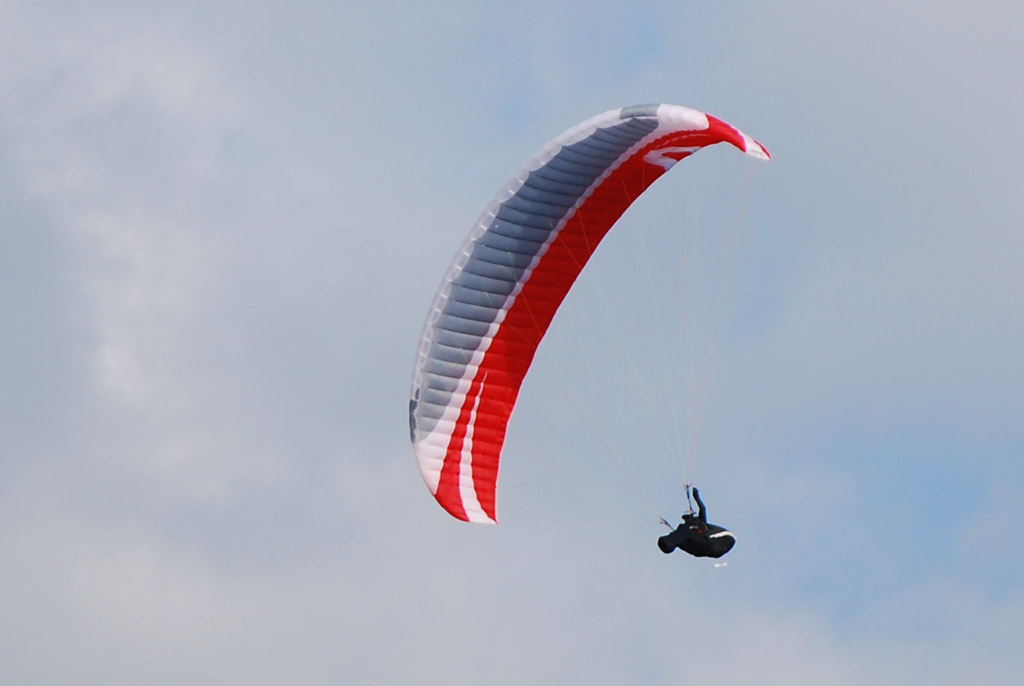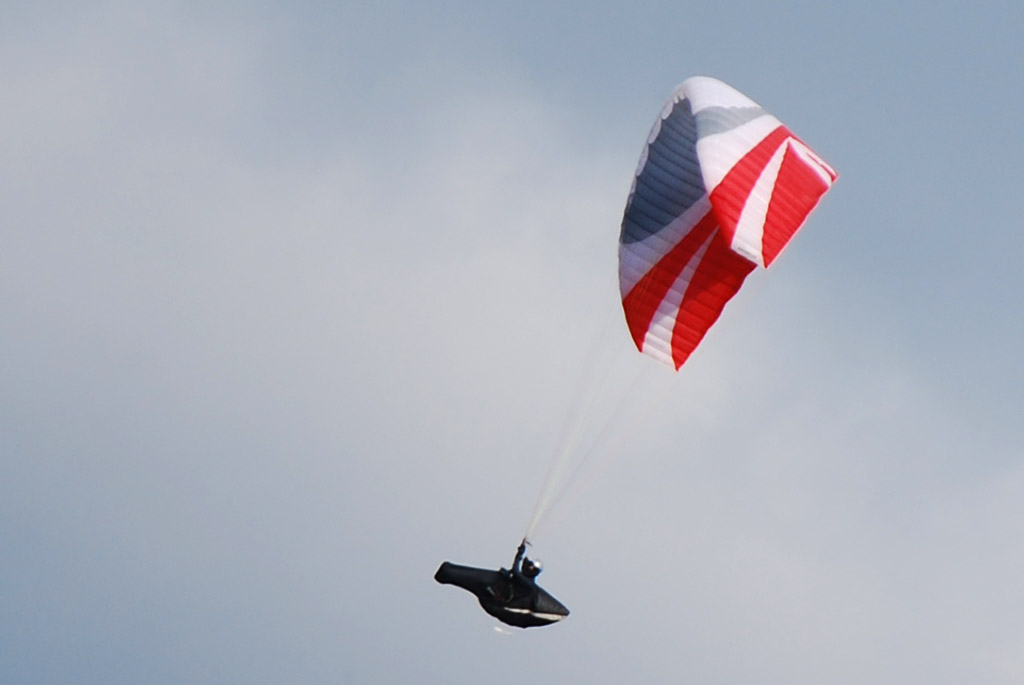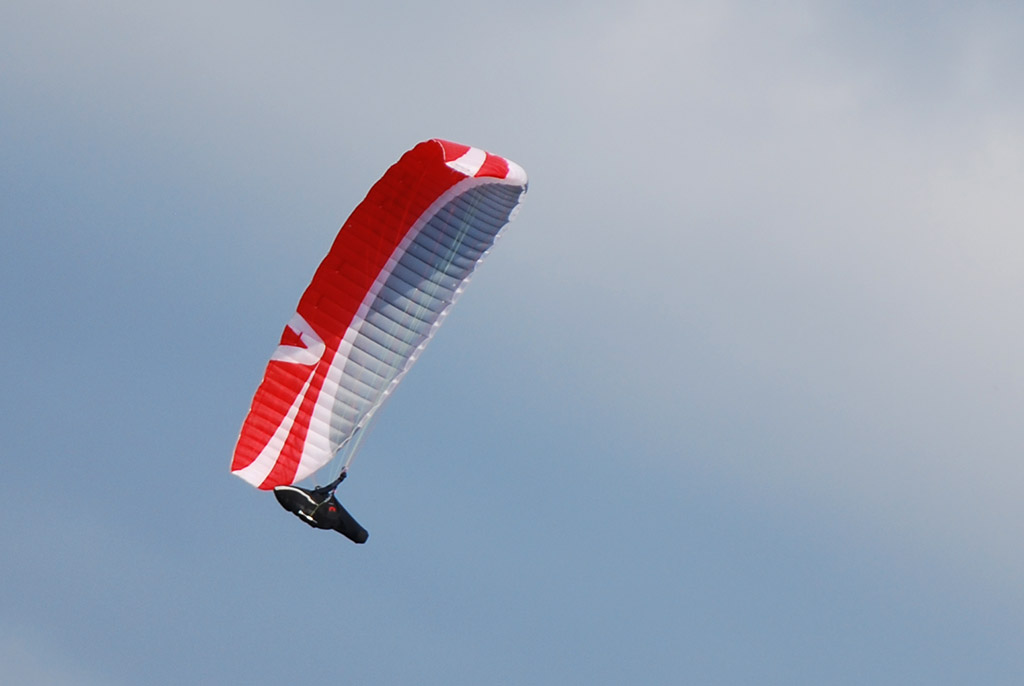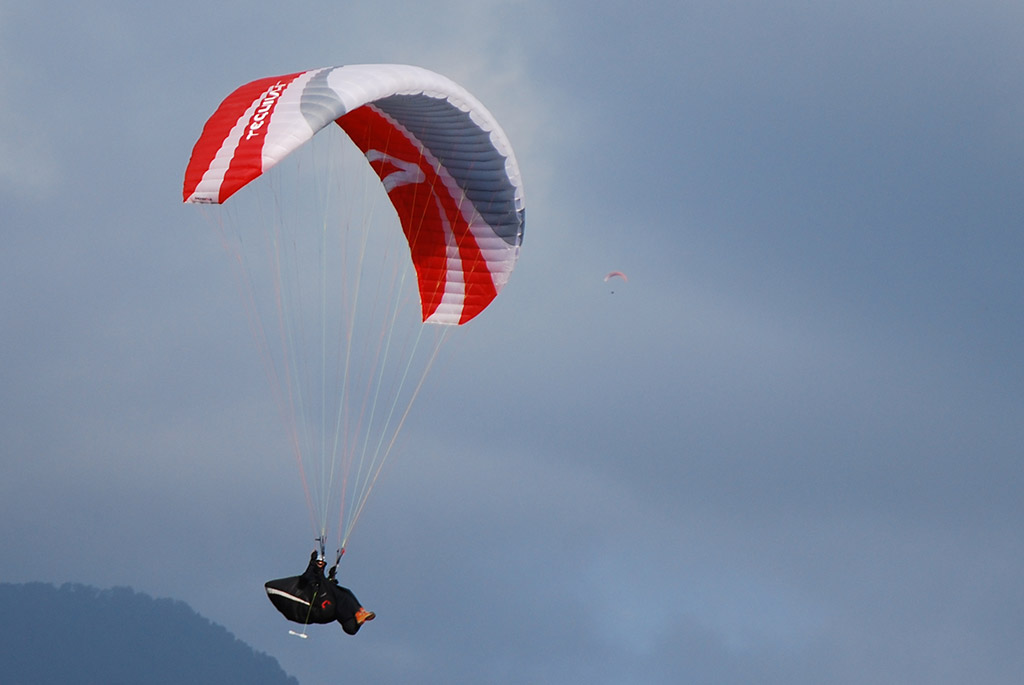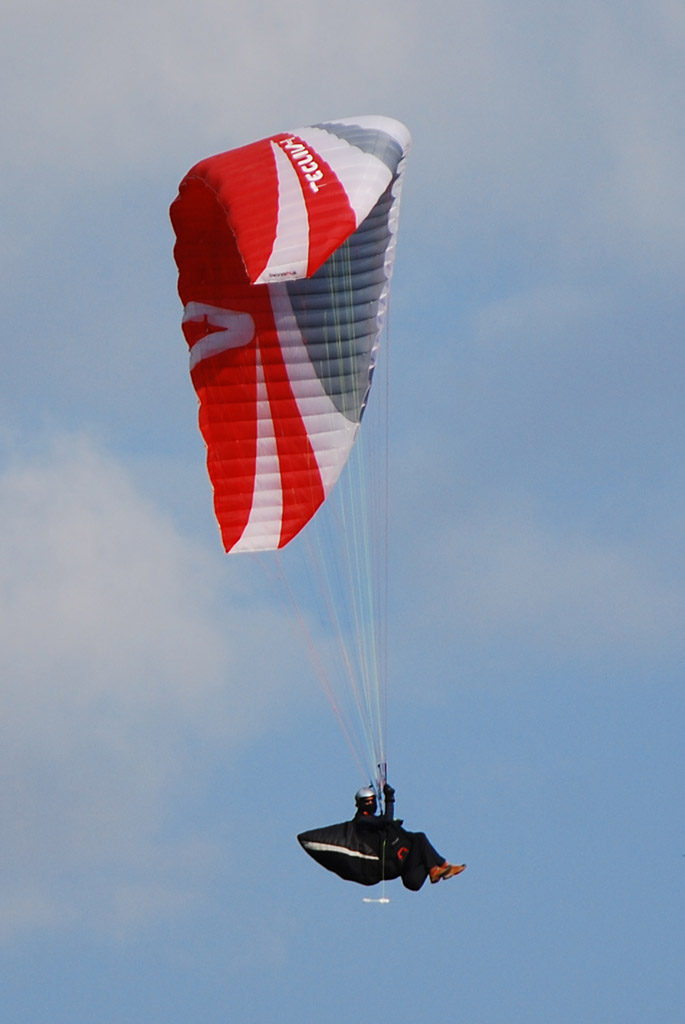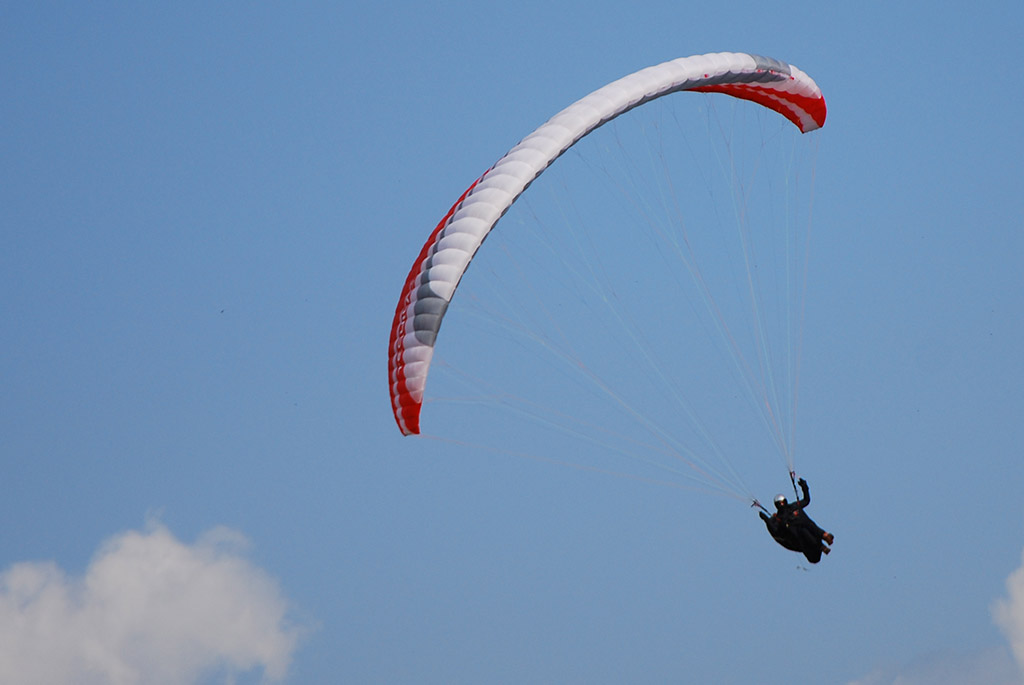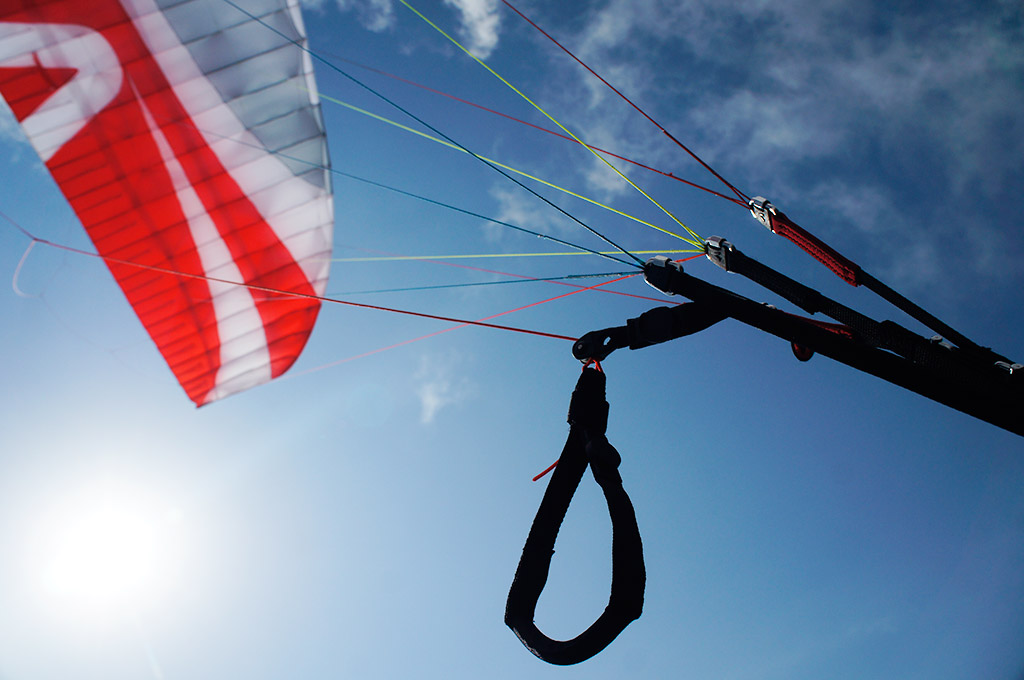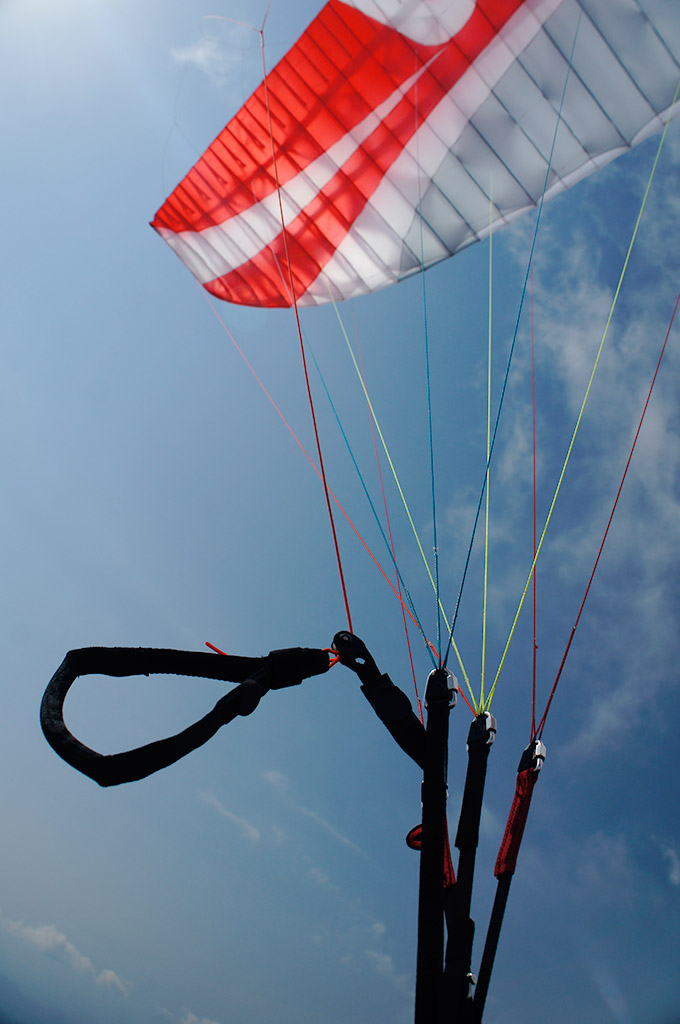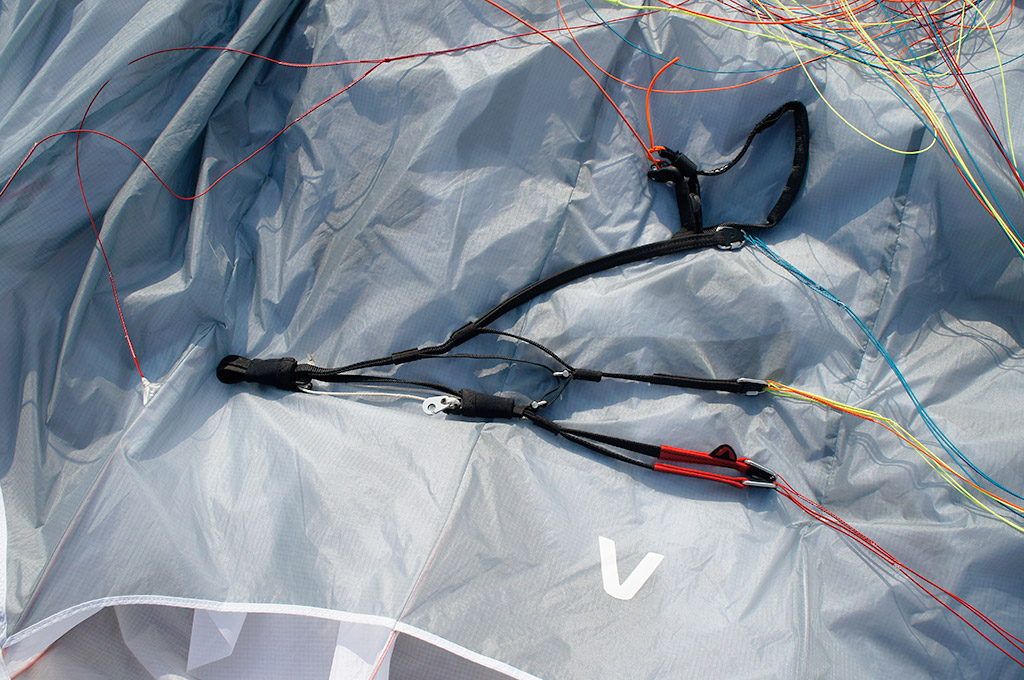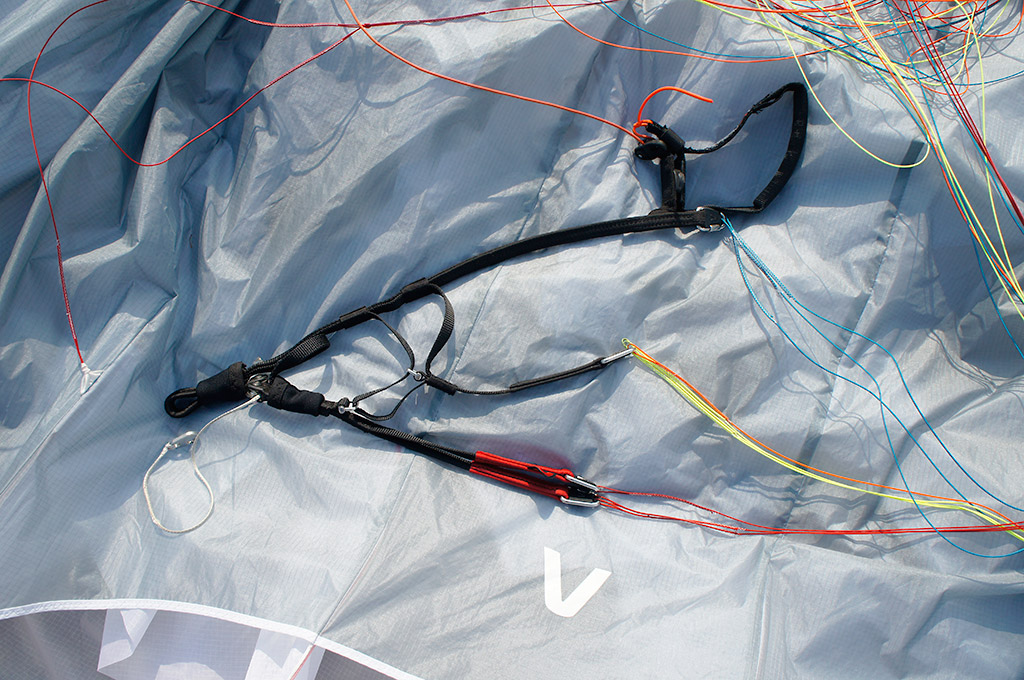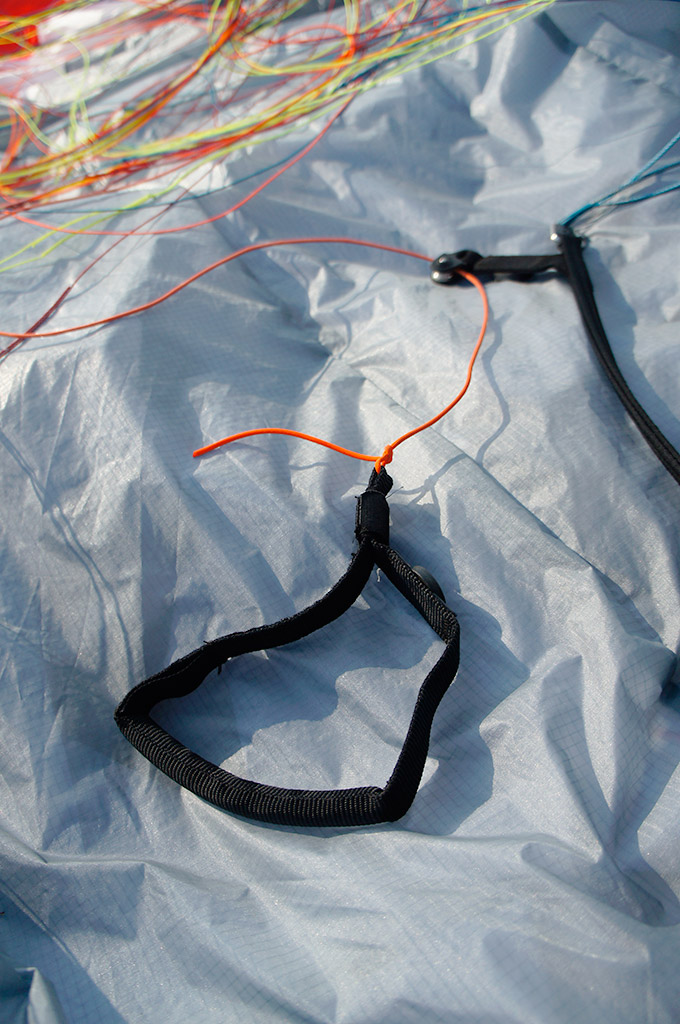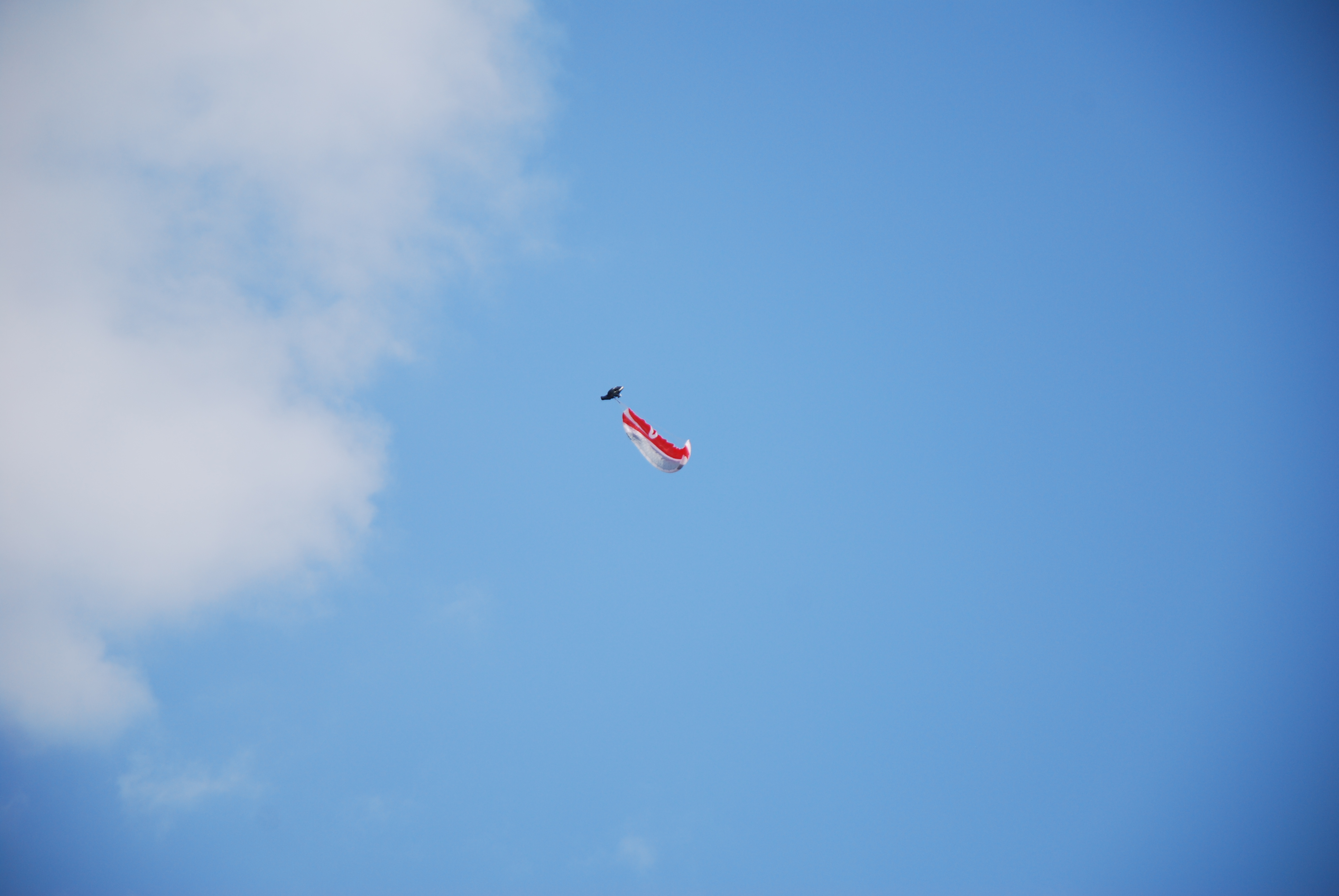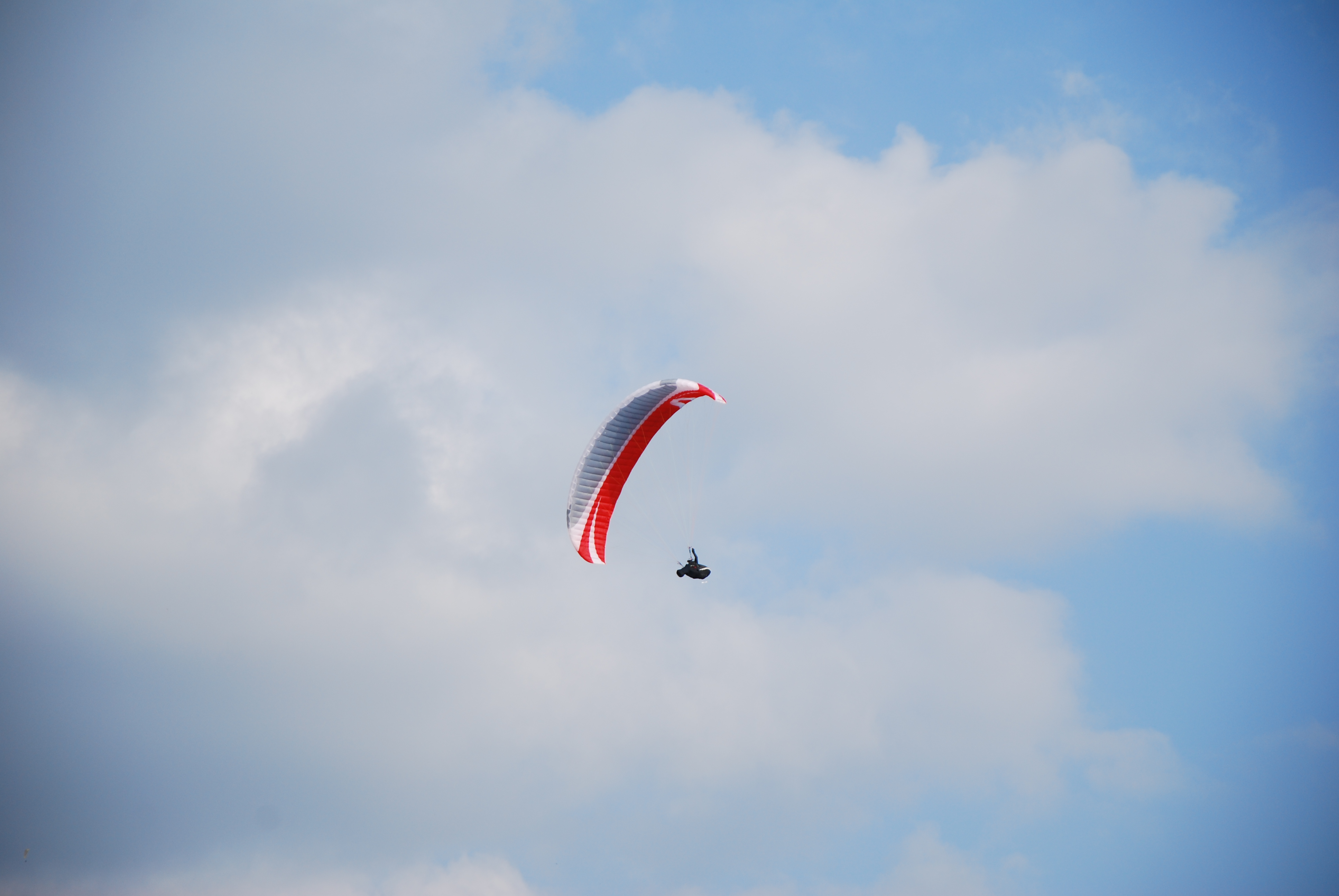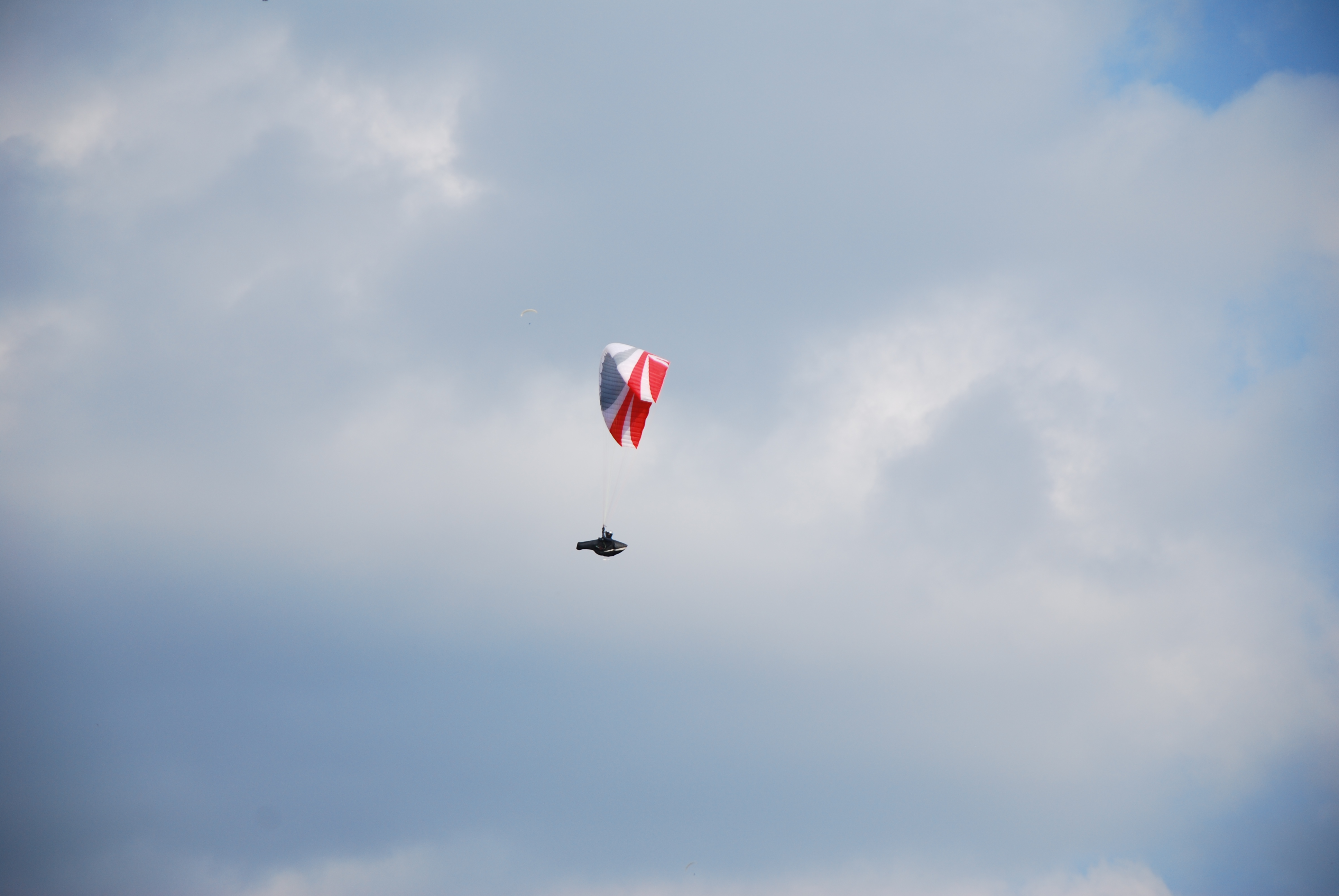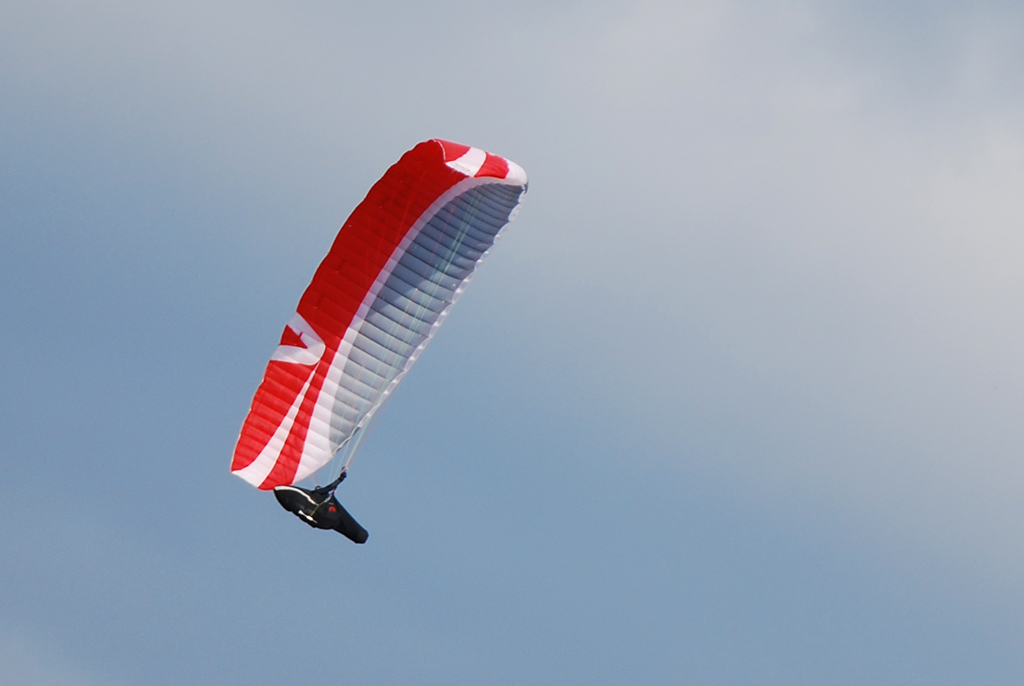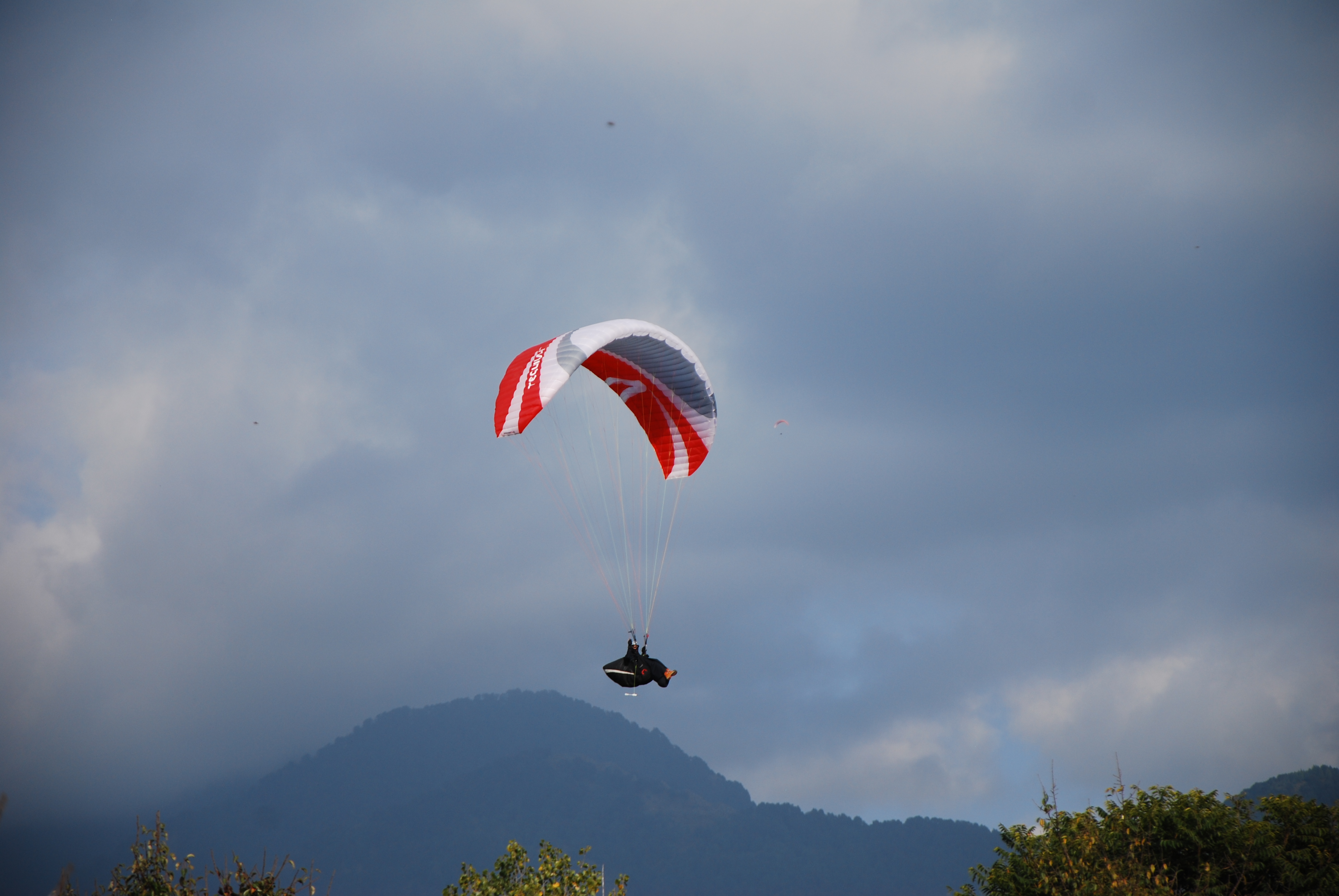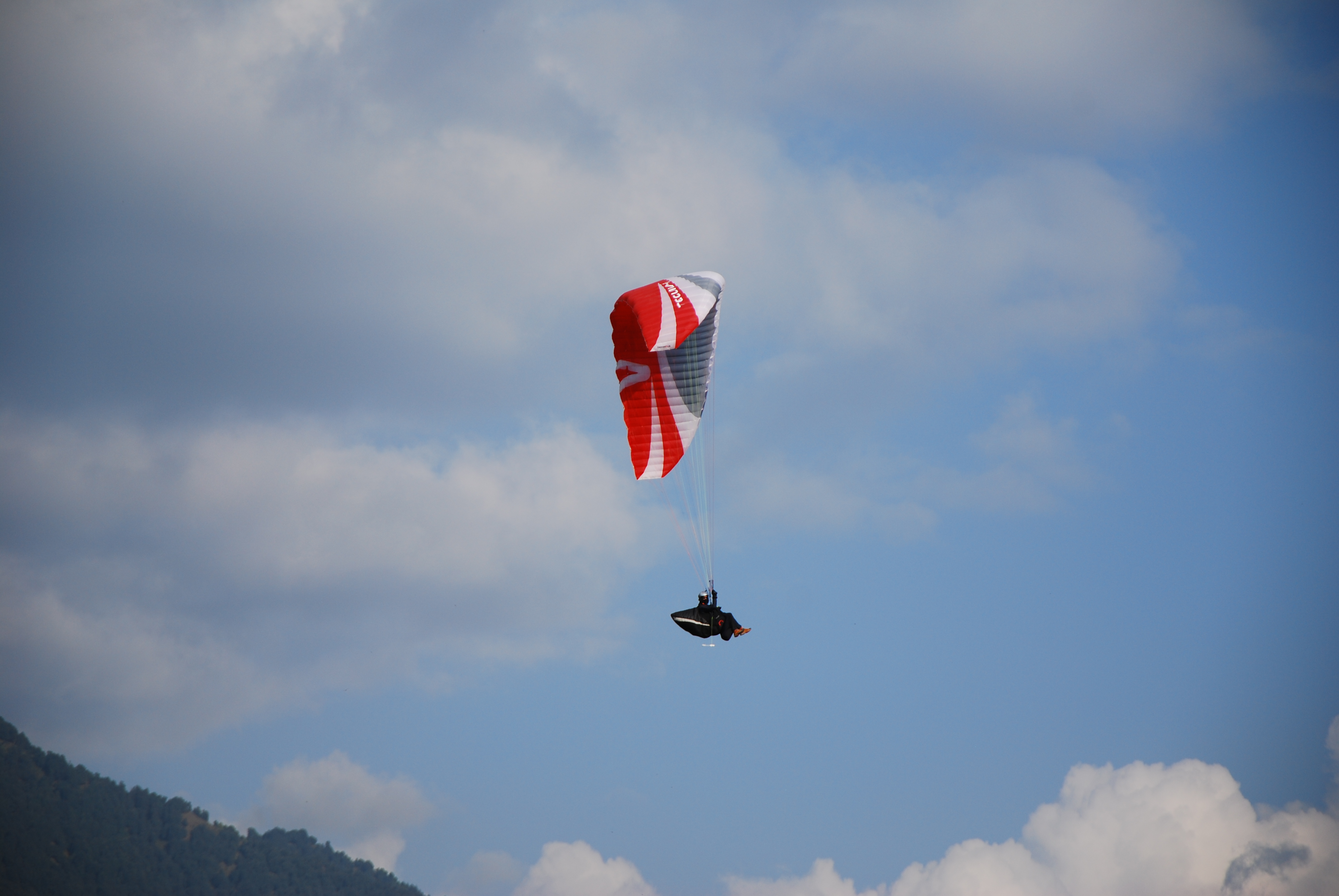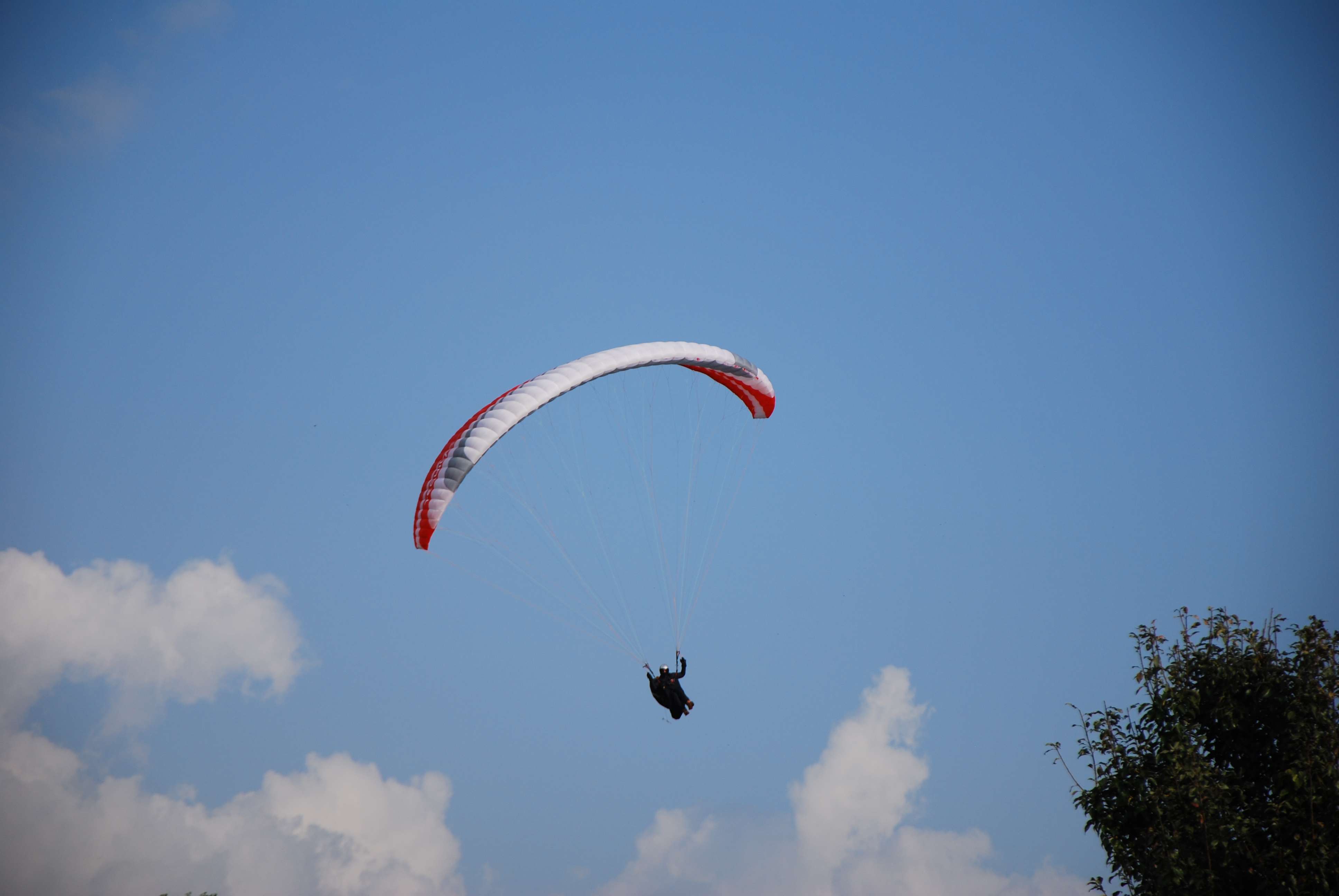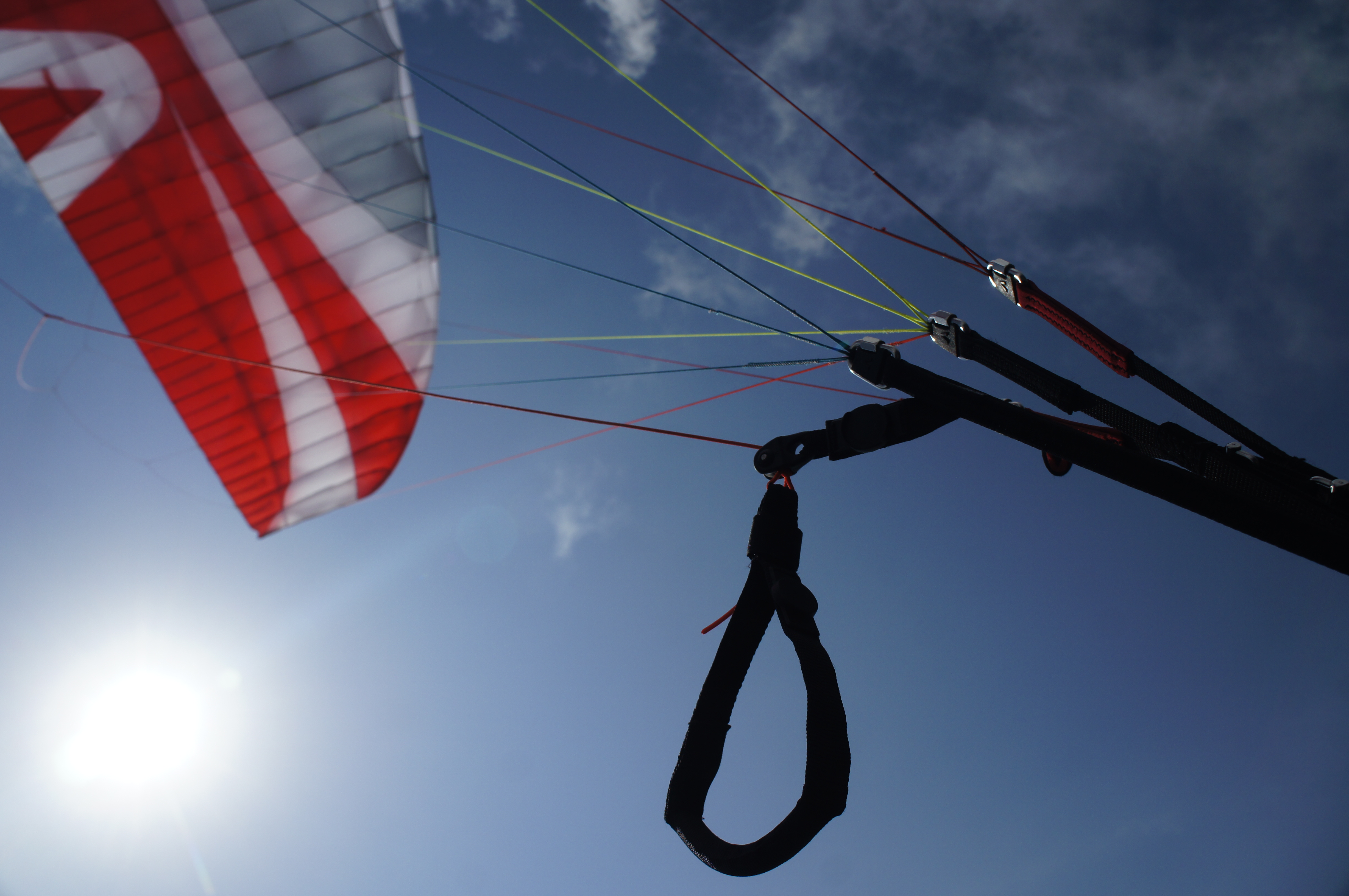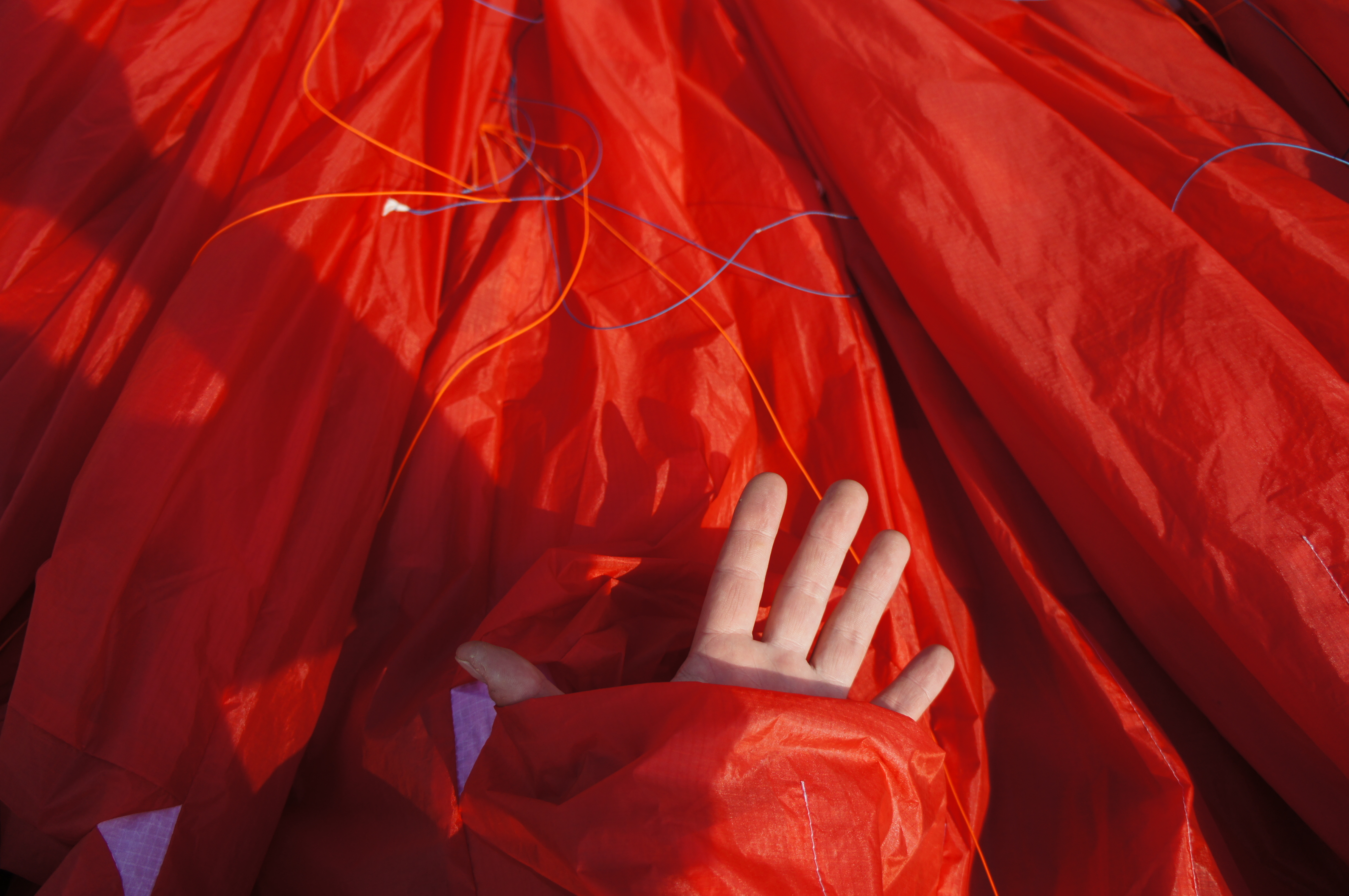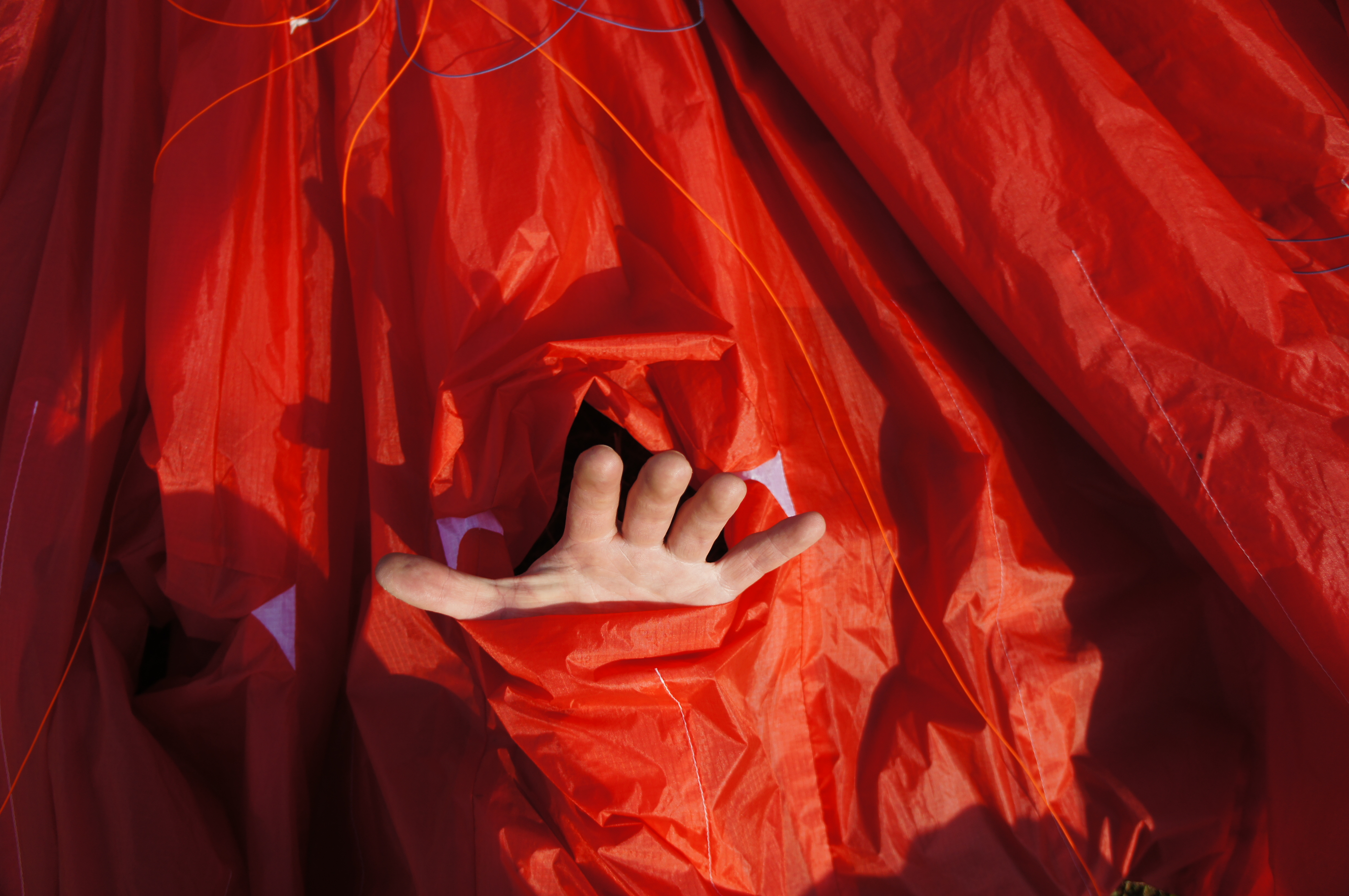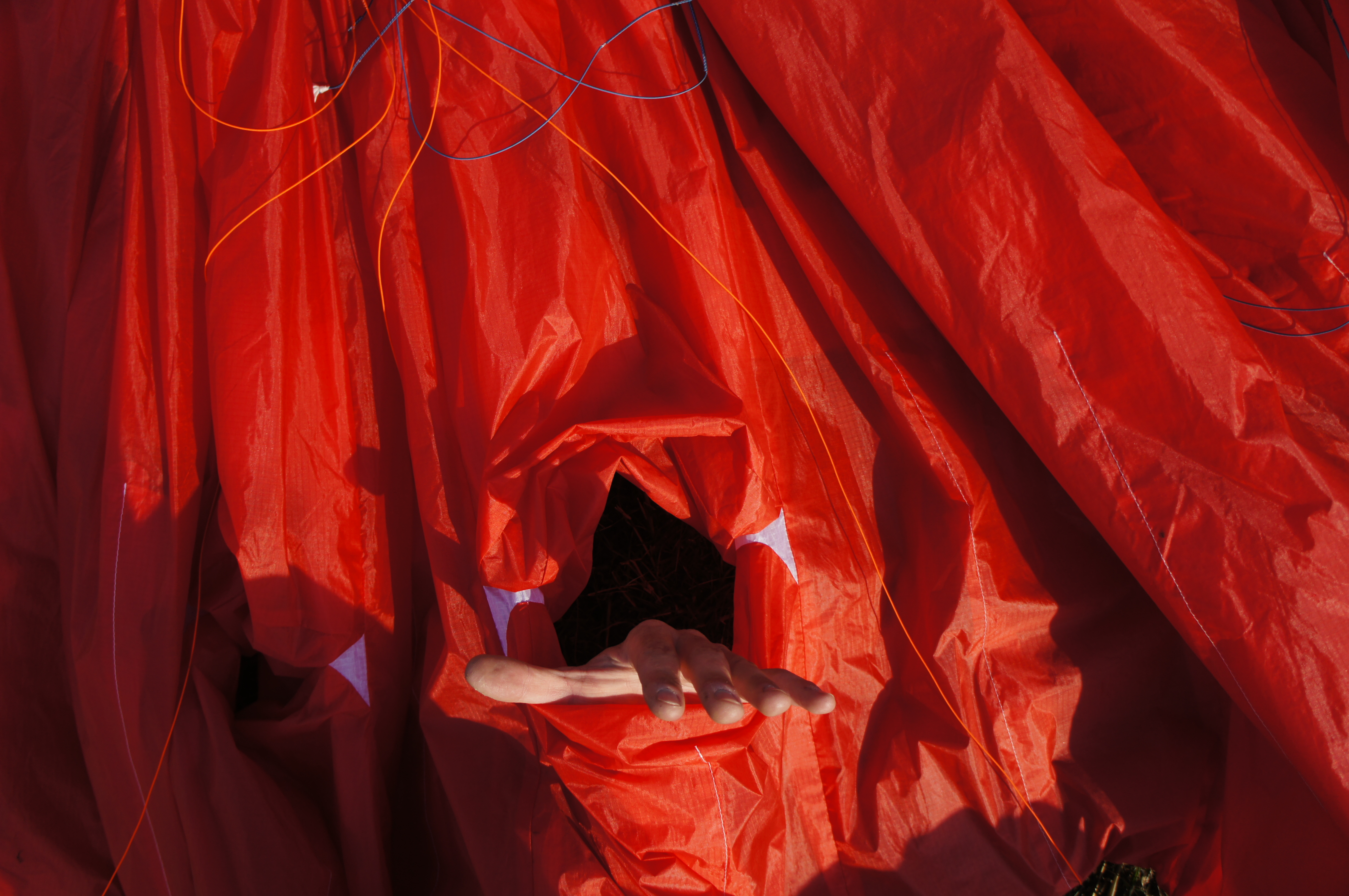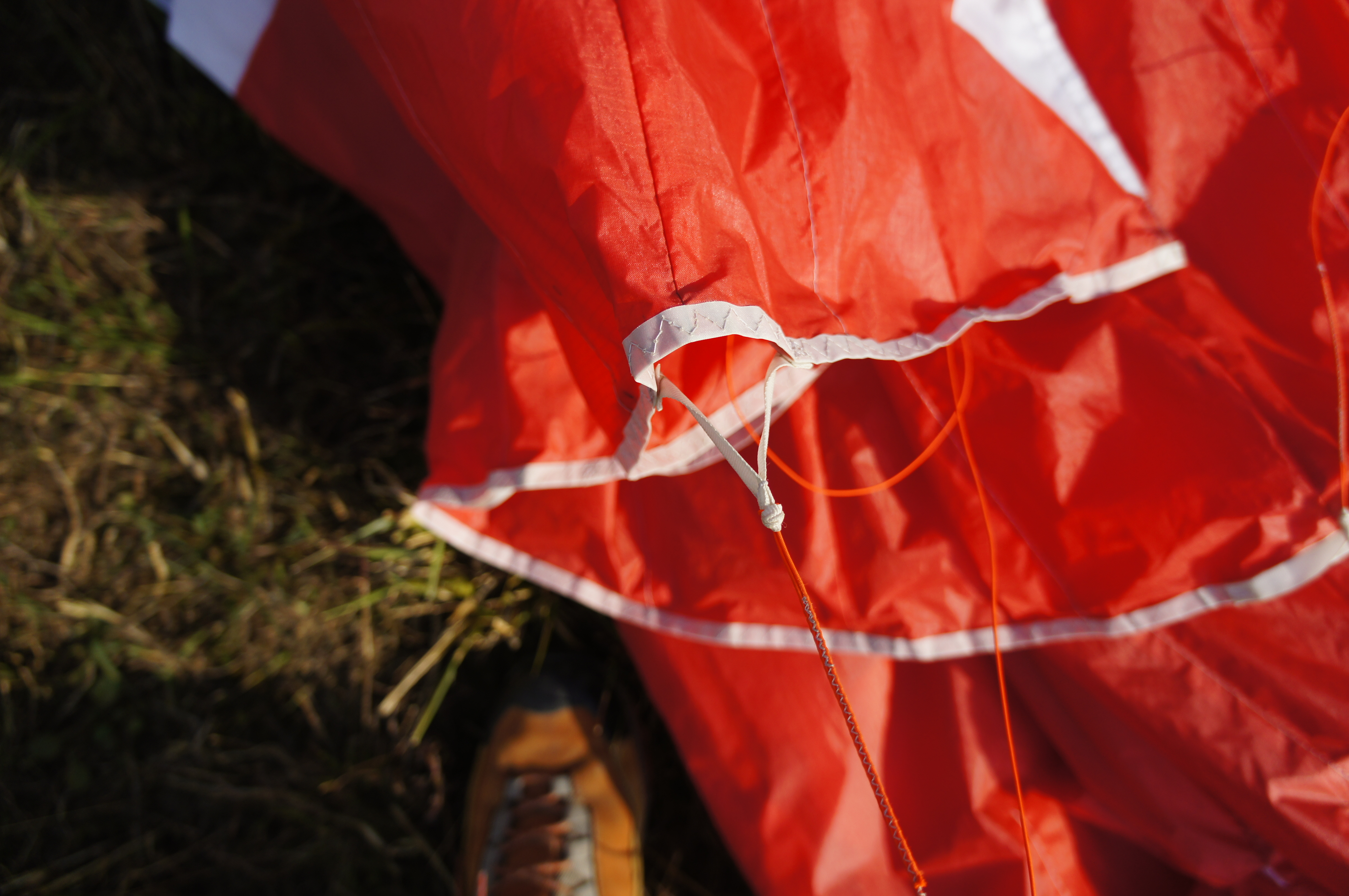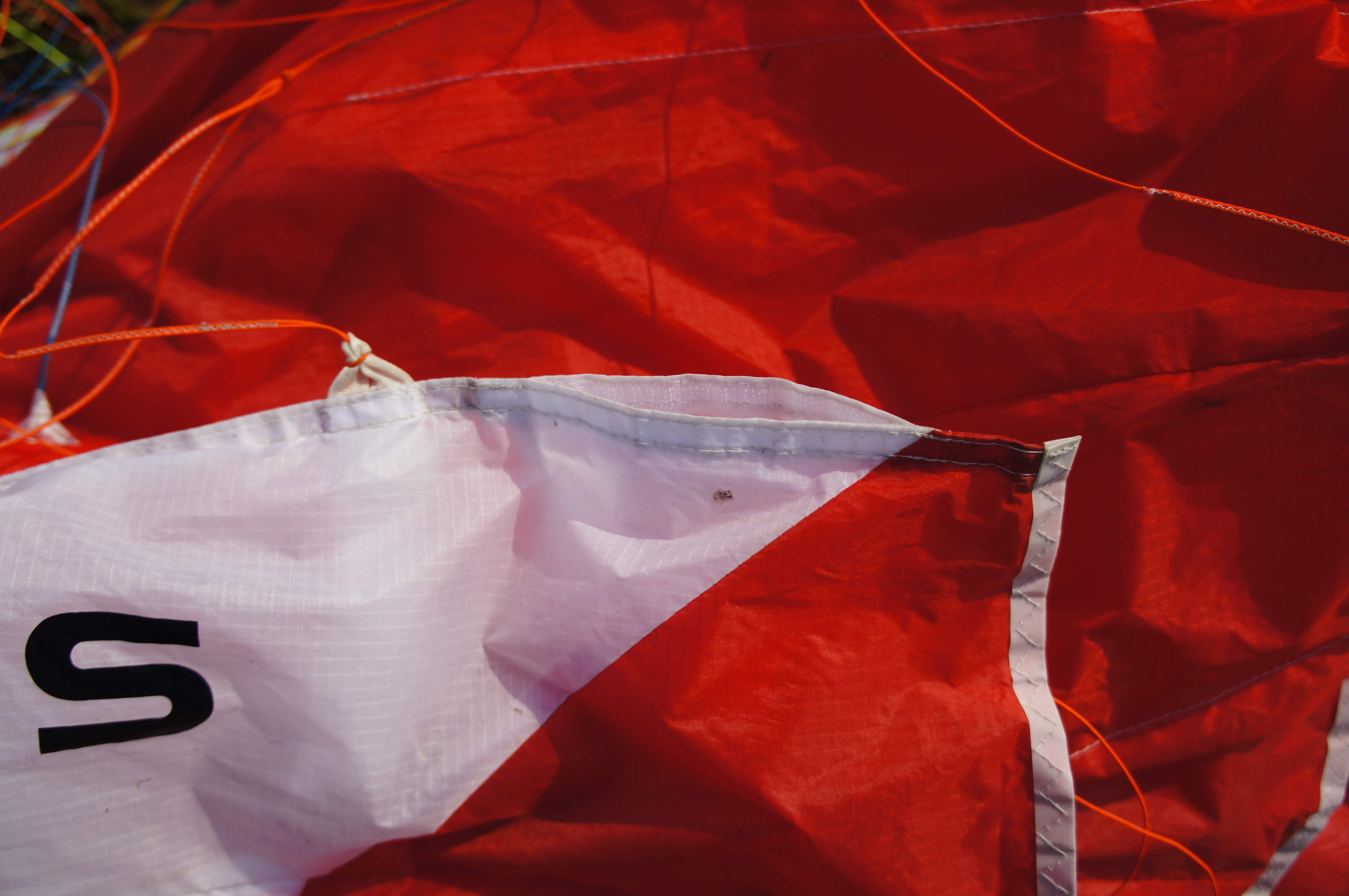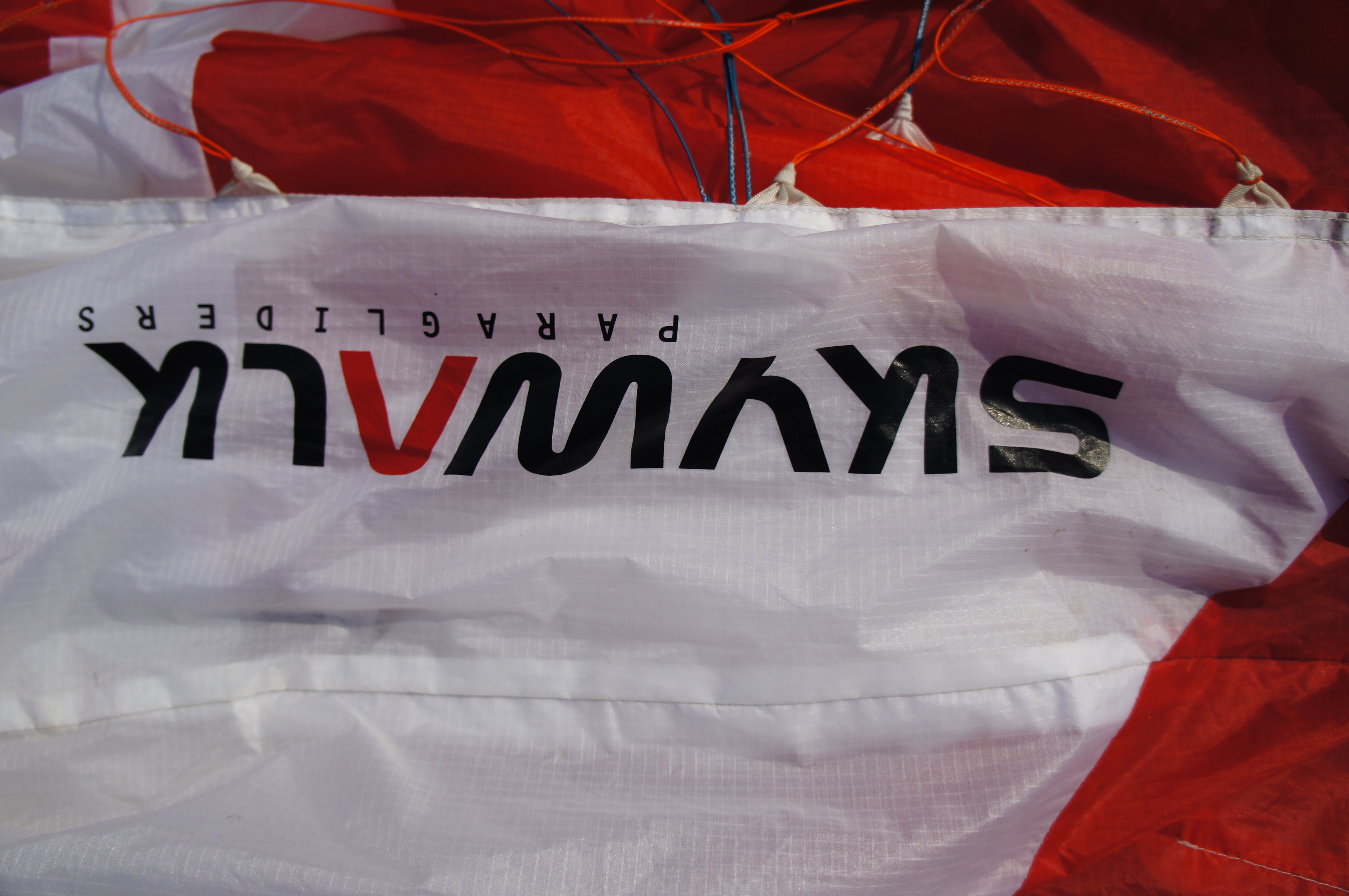Design
I remember one pilot asked me a question in private correspondence not so long ago, which practically stumped me. Are there perfectly safe but decently flyable "intermediates" on the 2014 paraglider market with braid-protected slings on all the tiers of the sling? I now know at least one positive answer to that question. Tequila4! Huge intakes, modest elongation, a pretty thick profile, finally, slings generously covered with braid from top to bottom - well everything, literally everything in the design of this machine literally screams out: "I am a humble after-school machine!" The machine has quite modern and narrow ends, big and handy brakes, and decent stroke of gas pedal wires made of soft and slippery dyneema that tells us nicely that our boy's gas pedal is not only intended for learning gas pedal flight modes and dodging clouds... The design is characteristic of Skywalk, bright and catchy. To my taste, this coloring best suits wings with relatively low elongation.
Flight
Bir is a specific place to fly. The ability to fly aggressive, sporty and with a real drive is very often and very much depends on the feeling of comfort and reliability that the wing gives to the pilot. Here you can see at the same altitude, at the same distance from the start, steep sports wings and simple machines almost for initial training. And, perhaps, it is under these conditions that the Tequila4 can most convincingly show what it can do.
Flying ability. The first, and perhaps the strongest surprise upon close acquaintance with Tequila is related precisely to volatility. A humpbacked horse indeed! Armed with a wireless pitot probe, I measure speed. Balancing speed, 38-40 kilometres an hour. First stage of gas pedal - wow, 48-50 km/h! Already very good for an after school wing. Second stage - 53-55 km/h! Yeah, there you go. Close to a record for a wing, carrying honestly the EN B label. At first I could not even believe in such optimistic results. I re-calibrated the sensor and flew another three hours. Numbers were the same! This alone would allow me to praise Tequila for its flying ability, but the pleasant surprises did not end there. Parallel flights with BGD Tala, Gin Carrera and Ozone Rush4 showed no significant loss in glide at speeds up to about 50 km/h. The difference, of course, was, but in the conditions of quite serious birch turbulence to feel it was not always possible. Under such conditions the one who can afford not to get off the gas pedal flies faster and better, and here Tequila lets you do its best. About it, however, below. The speed of descent was not a disappointment either, the Tequila4 made it possible to get out from the bottom of the valley a couple of times, which is not possible with every wing. In a thermal spiral, even a fairly tight one, the decline does not tend to increase significantly either.
Maneuverability. Traditionally one of the strong points of Skywalk gliders, and another one of the clear advantages of Tequila4. Tequila has a very characteristic, "Skywalk" turn, however, with some correction for wing positioning. Even with sharp enough brakes and weights, transitions are almost completely absent - the plane just goes into the desired roll, and that's it. Pilots unfamiliar with Skywalk can be a little confused at first, it is too easy. Oh yeah, it's time to mention the specifics of the Tequila4. Not only can you work with the swashbucklers, but you have to work with them unashamedly, amplitudinously, powerfully, and decisively. You can't expect great hand-hold feedback with the Tequila, but you don't need it for after school gliders (there's a serious Skywalk Chili3 for those who want precise and responsive control.) But you don't have to worry about dosing the hand travel and forces, which is a definite plus for an after school machine. Of course, it is possible to break off the Tequila, but in my opinion, only a very strong and long arms scared pilot can do it. And even then, probably, having previously wrapped one or two turns of the steering sling around his hand. A feature that is very useful for after-school winging. The GIN Atlas has similar brake inputs, but the Atlas is not as interesting as the Tequila. I suspect that the Tequila's high resistance to unintentional stall is also due to the presence of jet flaps - profiled holes in the rear part of the wing. It took me a while to figure out how to work with the Tequila in the thermals - my personal reluctance to use the brakes too much got in the way. But I could brave it and in the next term I put one hand down strongly (of course with a good weight on the same side) and the Tequila showed what it can do. A very compact, calm and smooth turn with a moderate descent, simple, clear and predictable. Once in a turn, the Tequila does not tend to follow its hand (as more advanced machines of a class or two higher often do) - but it grips into the turn with a dead grip, and even a flutter on the edge of a strong stream is almost unable to significantly change the roll and speed set by the pilot. The Tequila rolls back mechanically, not requiring any steering wheel thrusts, adjusting its weight or any other tricky tricks. It is pleasantly relaxing in heavy currents - in fact, all work with the wing in thermals is reduced to periodic flapping. Approximately the same impression was left by the wingovers. The main thing is not to be afraid! Don't be afraid to work with your arms bravely and with amplitude. And if these hands are skillful enough, from the second or third movement Tequila easily and effortlessly flies into a loop. I don't have any problems with sharp spirals (including "fight" ones, to escape from under the clouds) - you take more weight, work with your hands, and after a couple of rotations the speed of descent and overload will be so great that it won't be a problem.
Comfort and informativeness. I'm in the tank! Here's the first impression the Tequila gave me. The damping on all axes is clearly above average, even for an "after school" wing. At first it seems that even a serious roll is not enough to cause the Tequila to make strong roll and pitch motions. But this is only a first impression. After a good search, you can almost always find turbulence in Beer's flight zone that is so severe that even the Tequila can feel it. And this is where the interesting nuances begin. The Tequila, when it flies into the powerful and sharp ascending stream, is able to bend forward sharply - by 30 or 35 degrees - simultaneously unloading its front edge. This unloading is not especially critical - with passive pilot it usually finishes with slight crush of leading edge and slight warning crunch of fabric above head. But if you want to avoid such wing movements, you should use the brakes in the same way as in thermals. I.e. very amplitudinally, not straining your hands too much, or putting too much strain on them. For experienced pilot such style of piloting may be not very comfortable, but for "post-school" pilot (who the Tequila is designed for) it's OK. On the other hand, the passive safety of Tequila is so great that there is no need to compensate for everything. Intentionally not caring about active piloting, a couple of times I got "combat" asymmetric folds of 30-40 percent - and every time it was something in the style of "something rustled a little over the head, well, okay. A soft sort of rising and falling, one or two small roll motions, little loss of altitude, almost no deviation from the course - we fly on. And since everything is so good, constant and aggressive pitch compensation when flying on the Tequila is needed only for pedagogical purposes. In most cases the machine handles the pitch bump very well by itself, allowing the pilot to concentrate on piloting, tactics and just enjoying the flight. It begs the logical question - but what about informativeness? It's fine. Of course, such a silent machine can't reproduce air nuances as completely and vividly as the technics of higher classes - but in this case you don't need it. What is needed is that a not very experienced pilot, once he is in the ascending (or descending) airflow on the Tequila, can clearly understand what is going on and what to do about it. And the Tequila copes with this task quite confidently. The information content of the machine is more or less evenly distributed across multiple data channels - speed, pitch and roll motions are all quite informative. There is no jitteriness, no sudden movements of the wing above your head or sudden changes of hand load - everything is smooth and calm enough, and at the same time there is enough information to quickly and confidently find and center almost any stream. It is interesting that somewhat above average was the informativeness of the free ends - strong and narrow flows noticeably throw Tequila outward, it becomes clear at once, in what direction one should twist.
I'll single out one little noticeable effect, which, nevertheless, may displease some pilots. On long transitions, you may get a slight vibration of the lines on the second half of the gas pedal stroke. It doesn't affect anything, but in the absence of more serious faults these little things pay attention. It is quite possible that changing the wing loading may eliminate this problem.
Dynamics and power capacity. Average or even slightly below average. Good maneuverability allows to make powerful wing-overs and spirals on Tequila, but you should constantly watch your speed and try to have some reserve. In contrast to the sharper and meaner machines, the Tequila tends to lose and dissipate energy rather than store it in excess. This is perhaps especially pronounced on wingmen. It is not very difficult to get the Tequila to roll more than 90 degrees, but the risk of losing speed is higher than average. The lines in the leading edge save - even strong unloading associated with a lack of speed leads to folding with a probability far from 100%. Similar is the case on steep spirals. It's all very comfortable, it's not too difficult to control the angular velocity and rate of descent, but it does take a while to get up to speed. Overdrive landings with spectacular swoops are definitely not Tequila's native element. I mean, you can do something like that with a little bit of skill, but there are paragliders which do it much more effectively.
Dangerous Flying Modes
Asymmetric folding
Great. The Tequila has very heavy B-risers and it is very difficult to fold along the chord beyond the B-line (which is a modest 20-25% of the chord). The force on the A-strand when entering the fold is unexpectedly low, the leading edge breaks quite gently. After the folding, the machine moves smoothly backwards, only to flip forwards and sideways just as smoothly. It unfolds quickly, but without too much harshness and is not accompanied by sudden roll movements which are characteristic of more rigid machines. However, the Tequila likes to roll after being folded, but the amplitude of these movements is modest, and the periods are long enough. The amplitude of the oblique roll when leaving the mode is not more than 30-40 degrees, the loss of altitude is about 10 meters. Course deviation is hard to predict in advance due to some tendency of the Tequila to swing on the roll at the exit of the fold, but it is unlikely that the angle of deviation on course can exceed 90 degrees.
Frontal folding
Fine. It is unlikely to develop a deep chord fold; and what has been able to fold very quickly reveals itself immediately after throwing rows. the "ears," however, may remain folded, but in any case the exit is soft and somewhat protracted in time. The loss of altitude at the exit from the mode is 15-20 meters at most, often less. Exit in all attempts was strictly symmetrical.
Breakout from the thermal spiral
Somewhere between "excellent" and "failed. The load on my inside arm was too high, the machine tried too hard and too obvious to make a tight turn at the slightest mistake in dosing the load on the brakes. I was able to make a successful deceleration in not more than half of the cases.
Rapid Descent
Steep Helix
Outstanding. Moderate feel and power capacity of the brakes allowed good control of the helix without fear of a sudden increase in the rate of descent. No hint of spiral neutrality at -10 m/sec. The exit occurs as expected smoothly, it is not so easy to provoke the machine to a sharp exit from the spiral with a powerful "slide" and the subsequent strong flip. I used the steep "battle" spiral at least once to make an emergency drop under an intensely working cloud - no problems at all, even in turbulent air Tequila held the spiral reliably, without distracting the pilot by turbulence.
"Ears."
Very good. In modern paragliders, "ears" are often only stable within a narrow range of the A-row outer sling travel. With Tequila it's just the opposite: if you try very hard, you can find a hand position where the "ears" become unstable. One or two centimeters down or up, and everything is fine again. There is a slight tendency to "sticking"; one or two body movements or a couple of strokes of turbulent air - and "ears" open on their own. Reduction is within reasonable limits, around -3.
gas pedal "ears."
Same as without the gas pedal, only the reduction grows to about -3.5.
Conclusions
After school pilots tend to dream of a wing that is both very relaxed, safe, and comfortable - and that allows them to fly long, high, and far. Which implies good maneuverability and decent flyability. More often than not, such dreams remain dreams, crashing on the hard edges of harsh reality. Sometimes they give ultra-flying, but never safe wings to those who are not guilty in anything; on the contrary, they try to convince them that the flying ability is not so important as the safety. Finding the coveted compromise is not easy. But it seems that the Tequila4 successfully balances on a narrow border, on one side of which are reliable and comfortable "double planes" with cumbersome control andon the other side are the wings, generously endowed with flying and maneuverability, but given the EN B label by some misunderstanding. Skywalk's compromise remains a compromise - you can't expect the Tequila to be super-flyable, super-maneuverable, and super-safe at the same time - but overall it's a very, very good compromise. The Tequila's volatility is generally sufficient to fly difficult and long routes with confidence (assuming, of course, strong, preferably mountainous, weather). Top speed is excellent for an "after-school" wing. There are no problems with maneuverability. However, you can trust Tequila from the first flights, behaving well and comfortably even in quite serious turbulence. It's practically an ideal choice for a weekend pilot or a couple of day-trips a year. Minimum required flight time is 5-10 hours, no more.
Pros of
- Very comfortable, pleasant character
- High passive safety that meets honestly the EN B level
- High top speed, excellent combination of speed and quality in the right side of the polar
Cons
- Slight vibration of slings and ends at high speed
Features
- Long hand strokes when flying in strong weather
My thanks to the Skywalk dealer in Russia, Sergey Shelenkov, for providing the paraglider for the tests.
Photo: I.Tarasova, A.Tarasov

